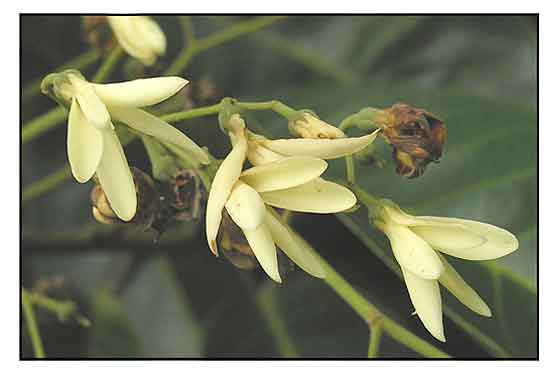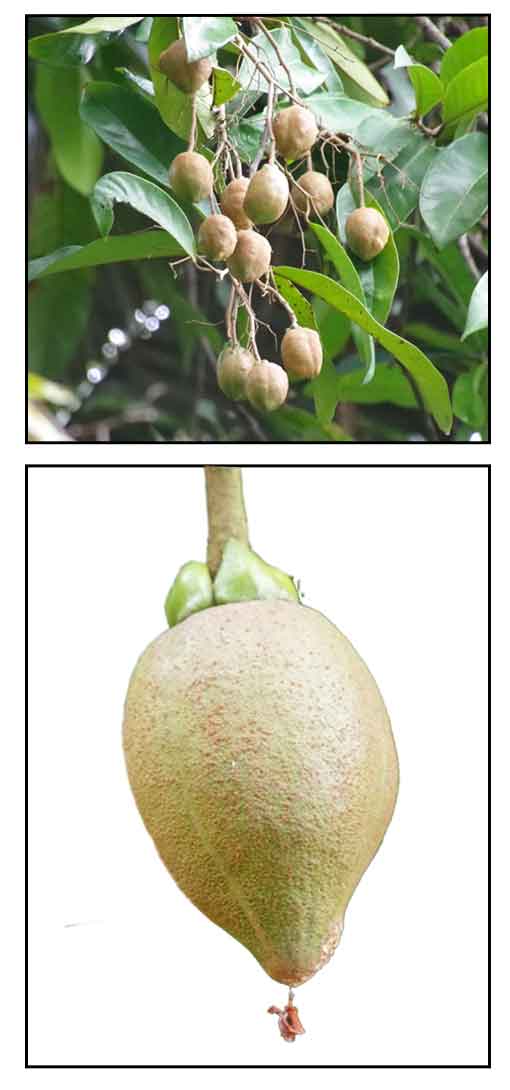 Gen info Gen info
- Vatica rassak is a tree in the family Dipterocarpaceae, native to maritime Southeast Asia.
- Etymology: The genus name Vatica derives from Latin "vates" meaning "a foreteller or prophet".The species epithet rassak derives from 'resak', the species; Malay common name. (2)
Botany
• Growth form: Large tree, able to grow up to about 30 - 35 m tall. Trunk: Sticky resin exudes from the tree when injured. Foliage: Green leaves, narrowly elliptic, simple and alternate arrangement, surface glabrous, distinct triangular stipules about 14 mm long. Flowers: White to whitish-yellow flowers borne on a panicle inflorescence. Fruit: Fruit is brownish-green, oblong-shaped, about 4 cm long. (3)
• Vatica rassak is a tree that can be 30 m tall with cylindrical trunk, of 20-70 cm of diameter, with brown-greyish bark from which exudes a resin of yellowish white color with reddish streaks. Leaves are simple, alternate, oblong-lanceolate with pointed apex and entire margin, 10-30 cm long and 5-10 cm broad, rather coriaceous, of glossy dark green color above, pale green or grayish green below. Drooping axillary and terminal panicle inflorescences with numerous hermaphroditic flowers of about 2 cm of diameter, with 5 green sepals, 5 free petals of white or white-cream color, and 5 stamina. Fruits are oblong capsules, 4-5 cm long and of 2,6-3 cm of diameter, of greenish brown color with persistent green calyx, containing one globose seed of about 1 cm of diameter. (11)
Distribution
- Native to the Philippines.
- Also native to Borneo, Maluku, New Guinea, Sulawesi. (1)
- On river banks, and dry ridges up to 500 m altitude.
 Constituents Constituents
- Study of stem bark isolated three resveratrol oligomers, vaticanols A, B and C, along with three known stilbenoids, resveratrol, piceid, and ε-viniferin. (6)
- Study of stem bark isolated stilbenoid trimers, Vaticanol G (1) and vaticaside D (2). Vaticanols D (3) and H-J (4-6) were elucidated to be stilbenoid hexamer or heptamer. (see study below) (7)
- Study of stem bark isolated five new stilbenoids (vaticanols E, F, and vaticasides A-C). (8)
- Phytochemical screening of V. rassak resin yielded moderate amounts of alkaloids, flavonoids, and saponins, with absence of tannins.
GC-MS analysis yielded mostly caryophyllene oxide (24.21%). (10)
- Study of bark of V. rassak isolated vaticanol D, a resveratrol hexamer.
(see study below) (12)
Properties
- Studies have suggest cytotoxicity, anti-colon cancer, scavenging properties.
Parts used
Stem bark, resin.
Uses
Edibility
- No studies found on edibility.
Folkloric
- No reported folkloric medicinal use in the Philippines.
Others
- Resin: Dead stems yield a resin known as 'Damar Hiroe'. Resin from the plant is called 'Rose Dammar'. Dammar is a hard resin, used for caulking boats and baskets, as an adhesive, as medicine, as fuel for torches. It is used as ingredient of inks, lacquers, oil paints, varnishes, etc., and as glazing agent in foods. (4)
- Wood: Difficult to saw because
of clogging due to gummy resins. Used for turnery, heavy construction, mining timbers, railroad cross-ties, boat construction. (4) - Considered by many as one of the best
timber woods.
Studies
• Cytotoxicity Against KB Cells / Stem Bark: Study of stem bark isolated stilbenoid trimers, Vaticanol G (1) and vaticaside D (2). Vaticanols D (3) and H-J (4-6) were elucidated to be stilbenoid hexamer or heptamer. The hexamers 3, 4 and 5 and heptemer 6 showed cytotoxicity against KB cells. (7)
• Vaticanol C / Cytotoxicity Against Colon Cancer Cell Lines / Stem Bark: Study of stem bark isolated a novel resveratrol tetramer, vaticanol C, which markedly suppressed cell growth through induction of apoptosis, characterized by nuclear changes and DNA ladder formation, in three different human colon cancer cell lines. (9)
• Dipterocarps Resin for Functional Usage: GC-MS analysis yielded mostly caryophyllene oxide (24.21%). It is presumed to be useful for treatment of pain, a substance for sedation in anesthesia, anticancer, and anti-inflammatory agent. (see constituents above) (10)
• Vaticanol D / Scavenging Activity / Bark: Study of bark of V. rassak isolated vaticanol D, a resveratrol hexamer. Vaticanol D possessed scavenging activity of superoxide oxide. (12)
• Vaticanol C / Antitumor Effect / Mechanism / Stem Bark: Study of stem bark of Vatica rassak isolated 20 resveratrol (3,5,4'-trihydroxystilbene) (Res) derivatives and were evaluated for invitro cytotoxicity against a panel of human tumor cell lines. Seven compounds displayed marked cytotoxicity. Vaticano C, a major component, induced considerable cytotoxicity in all cell lines and exhibited growth suppression in colon cancer cell lines at low dose. Vat C cause two cell lines (SW480 and HL60) to induce cell detah at four to seven times lower concentrations compared with Res. Growth suppression was via apoptosis, evidenced by morphological findings of nuclear condensation and fragmentation and DNA ladder formation in the colon cancer cell lines. Apoptosis in SW480 cancer cells was via activation of caspase-3. Results suggest Vat C induced marked apoptosis in malignant cells by affecting mitochondrial membrane potential. (13)
Availability
Wild-crafted. |

![]()




 Constituents
Constituents